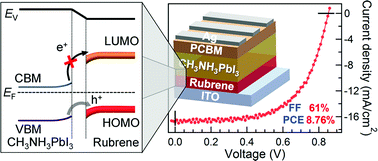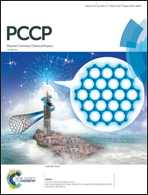Interfacial electronic structures revealed at the rubrene/CH3NH3PbI3 interface
Abstract
The electronic structures of rubrene films deposited on CH3NH3PbI3 perovskite have been investigated using in situ ultraviolet photoelectron spectroscopy (UPS) and X-ray photoelectron spectroscopy (XPS). It was found that rubrene molecules interacted weakly with the perovskite substrate. Due to charge redistribution at their interface, a downward ‘band bending’-like energy shift of ∼0.3 eV and an upward band bending of ∼0.1 eV were identified at the upper rubrene side and the CH3NH3PbI3 substrate side, respectively. After the energy level alignment was established at the rubrene/CH3NH3PbI3 interface, its highest occupied molecular orbital (HOMO)–valence band maximum (VBM) offset was found to be as low as ∼0.1 eV favoring the hole extraction with its lowest unoccupied molecular orbital (LUMO)–conduction band minimum (CBM) offset as large as ∼1.4 eV effectively blocking the undesired electron transfer from perovskite to rubrene. As a demonstration, simple inverted planar solar cell devices incorporating rubrene and rubrene/poly(3,4-ethylenedioxythiophene):poly(styrenesulfonate) (PEDOT:PSS) hole transport layers (HTLs) were fabricated in this work and yielded a champion power conversion efficiency of 8.76% and 13.52%, respectively. Thus, the present work suggests that a rubrene thin film could serve as a promising hole transport layer for efficient perovskite-based solar cells.



 Please wait while we load your content...
Please wait while we load your content...